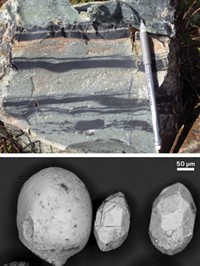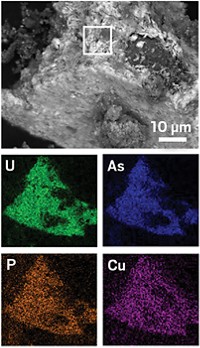Advertisement
Grab your lab coat. Let's get started
Welcome!
Welcome!
Create an account below to get 6 C&EN articles per month, receive newsletters and more - all free.
It seems this is your first time logging in online. Please enter the following information to continue.
As an ACS member you automatically get access to this site. All we need is few more details to create your reading experience.
Not you? Sign in with a different account.
Not you? Sign in with a different account.
ERROR 1
ERROR 1
ERROR 2
ERROR 2
ERROR 2
ERROR 2
ERROR 2
Password and Confirm password must match.
If you have an ACS member number, please enter it here so we can link this account to your membership. (optional)
ERROR 2
ACS values your privacy. By submitting your information, you are gaining access to C&EN and subscribing to our weekly newsletter. We use the information you provide to make your reading experience better, and we will never sell your data to third party members.
Geochemistry
Earth’s largest iron ore deposit may have formed later than thought
The work is the first to directly date an iron oxide deposit
by Carolyn Wilke, special to C&EN
July 29, 2024

The world’s largest iron ore deposit, found in western Australia, may have formed 1.4 to 1.1 billion years ago during the breakup of a supercontinent and the formation of Australia. That would make the ore up to one billion years younger than geologists have thought and may provide clues about other places where iron-rich deposits could be mined (Proc. Natl. Acad. Sci. U.S.A. 2024, DOI: 10.1073/pnas.2405741121).
Current methods to gauge the age of these ores are indirect, says Liam Courtney-Davies, a geologist at University of Colorado, Boulder. Instead of dating hematite, the iron-rich mineral in ore, they date a phosphorus-containing mineral that occurs along with hematite. “This mineral xenotime—it’s making up less than 0.001% of the ore,” says Courtney-Davies, who did this work while at Curtin University. Xenotime may have been formed through different processes than those that produced the hematite. “We think it was a red herring.”
Researchers can date most minerals on Earth based on the decay of two uranium isotopes to two lead isotopes. But no one had done this for iron oxide before. Concentrations of uranium in iron oxide are very low, Courtney-Davies says. He and his colleagues spent years working to make their reference standard and fine-tune their dating protocols.
The team measured the concentration of uranium and lead isotopes for hematite from eight drill core samples provided by mining companies. The dates from the new analysis put the age of the ore deposit at one billion to a few hundred million years later than previous studies suggest. Based on the timing, the ore could have been created by the breakup of a supercontinent that connected part of Australia to the area that is now South Africa and a subsequent landmass merger that formed the present Australian continent. These global processes may have provided the energy and hydrothermal flows needed to produce the iron oxide, the authors suggest.
“It’s a solid piece of analytical work,” says Paulo Vasconcelos, a geochemist and geochronologist at the University of Queensland who was not part of the research. Geologists have thought of the timeframe during which the work suggests the deposit formed as relatively boring. The study, “if it is proven to be correct, would be very significant, because it opens a whole new window of time that we should be investigating more carefully.”
“It is an interesting study with bold conclusions,” says Birger Rasmussen, a geologist at the University of Western Australia who was not involved with the work, by email. But researchers know little about the behavior of lead and hematite during geological processes. The new dates may miss the earliest stages of iron oxide mineralization, so future work should investigate how the timeline relates to hematite growth.
The new dates conflict with several lines of indirect evidence pointing to an earlier origin of the ore. “This study has thrown the cat amongst the pigeons,” Rasmussen says. “Time will tell what the hematite ages really mean.”
Understanding the conditions, such as the geological makeup and history, around this ore’sformation could guide mining companies in where to look for iron-rich deposits. “Most of what drives this [research] is somebody wants to make money,” Vasconcelos says. The hematite deposits in western Australia are the most economically important iron ores in the world. Not all iron-containing deposits are as enriched in iron. “So they want to find lots more of the same thing.”





Join the conversation
Contact the reporter
Submit a Letter to the Editor for publication
Engage with us on Twitter